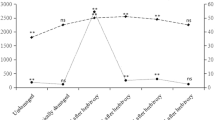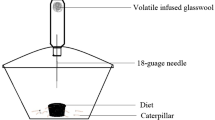Abstract
We investigated the role of experience with several antifeedants on the feeding behavior of a generalist herbivore, Trichoplusia ni. Second-, third-, and fifth-instar larvae of T. ni were examined for their feeding responses to plant extracts (Melia volkensii, Origanum vulgare) and individual plant allelochemicals (cymarin, digitoxin, xanthotoxin, toosendanin, and thymol), after being exposed to them continually beginning as neonates. All tested instars of T. ni were capable of showing a decreased antifeedant response following prolonged exposure to most of the antifeedants tested compared with their naive conspecifics. Cardenolides (digitoxin and cymarin) were the exceptions. The response to oregano was affected as a result of previous exposure to different concentrations of oregano, unlike M. volkensii, leading us to conclude that T. ni sensitivity varies between stimuli and cannot be generalized. To demonstrate that decreased deterrence following prolonged exposure to M. volkensii was the result of learned habituation, three aversive stimuli were used. A high concentration of the particular antifeedant, xanthotoxin, acted as a noxious stimulus and dishabituated (reversed) the decrement in the antifeedant response to M. volkensii. Cold shock or CO2 was marginally effective in dishabituating the response. The fact that the decrease in antifeedant response can be dishabituated has implications for pest management.
Similar content being viewed by others
REFERENCES
Berdegue, M., White, K. K., and Trumble, J. T. (1997). Feeding deterrence of Spodoptera ex-igua (Lepidoptera: Noctuidae) larvae by low concentrations of linear furanocoumarins. Environ. Entomol. 26: 912–919.
Berenbaum, M. R., Nitao, J. K., and Zangeri, A. R. (1991) Adaptive variation in the fura-nocoumarin composition of Pastinaca sativa (Apiaceae). J. Chem. Ecol. 17: 207–215.
Bernays, E. A. (1983). Antifeedants in crop pest management. In Whitehead, D. L., and Bowers, W. S. (eds.), Natural Products for Innovative Pest Management, Pergamon Press, Oxford, pp. 259–271.
Bernays, E. A., and Chapman, R. F. (1978). Plant chemistry and acridoid feeding behavior. In Harborne, J. B. (ed.), Coevolution of Plants and Animals, Academic Press, London, pp. 99–141.
Bernays, E. A., and Chapman, R. F. (1994). Host Plant Selection by Phytophagous Insects, Chapman and Hall, New York, pp. 206–229.
Bernays, E. A., and Chapman, R. F. (2000). Plant secondary compounds and grasshoppers: Beyond plant defenses. J. Chem. Ecol. 26: 1773–1794.
Bernays, E. A., and Weiss, M. R. (1996). Induced food preferences in caterpillars: the need to identify mechanism. Entomol. Exp. Appl. 78: 1–8.
Blaney, W. M., Schoonoven, L. M., and Simmonds, M. S. J. (1986). Sensitivity variations in insect chemoreceptors; A review. Experentia 42: 13–19.
Bomford, M. K., and Isman, M. B. (1996). Desensitization of fifth instar Spodoptera litura to azadirachtin and neem. Entomol. Exp. Appl. 81: 307–313.
Carew, T. J., and Sahley, C. L. (1986). Invertebrate learning and memory: From behavior to molecules. Annu. Rev. Neurosci. 9: 435–487.
Chen, W., Isman, M. B., and Chiu, S. F. (1995). Antifeedant and growth inhibitory effects of the limonoid toosendanin and Melia toosendan extracts on the variegated cutworm, Peridroma saucia. J. Appl. Entomol. 119: 367–370.
Chiu, S. F. (1984). The active principles and insecticidal properties of some Chinese plants with special reference to Meliaceae. In Schmutterer, H., and Ascher, K. R. S. (eds.), Natural Pesticides from the Neem Tree and Other Tropical Plants, Proc. 2nd Int. Neem Conf., Schrift der GTZ 161: 255–262.
Chiu, S. F. (1985). Experiments on the application of toosendanin, a natural product form Melia toosendan for the control of the cabbageworm (Pieris rapae L.). Acta Phytophylact. Sin. 12: 125–132.
Chiu, S. F. (1989). Recent advances in research on botanical insecticides in China. In Aranson, B. J. R. Philogene and Morand, P. (eds.), Insecticides of Plant Origin, Am. Chem. Soc. Symp. Ser. 387, pp. 69–77.
Dethier, V. G. (1982). Mechanisms of host-plant recognition. Entomol. Exp. Appl. 31: 49–56.
Dimock, M. B., Renwick, J. A. A., Radke, C. D., and Sachdev-Gupta, K. (1991). Chemical constituents of an unacceptable crucifer, Erysimum cheiranthoides, deter feeding by Pieris rapae. J. Chem. Ecol. 17: 525–533.
Gill, J. S. (1972). Studies on Insect Feeding Deterrents with Special Reference to Fruit Extracts of the Neem Tree, Azadirachta indica A. Juss. Ph.D. thesis, University of London, London.
Huang, X. P., and Renwick, J. A. A. (1994). Cardenolides as oviposition deterrents to two Pieris species: Structure-activity relationships. J. Chem. Ecol. 20: 1039–1051.
Huang, X. P., and Renwick, J. A. A. (1995). Cross habituation to feeding deterrents and acceptance of a marginal host plant by Pieris rapae larvae. Entomol. Exp. Appl. 76: 295–302.
Hummelbrunner, L. A., and Isman, M. B. (2001). Acute, sublethal, antifeedant, and synergistic effects of monoterpenoid essential oil compounds on the tobacco cutworm, Spodoptera litura. J. Agr. Food Chem. 49(2): 715–720.
Isman, M. B. (2002). Insect antifeedants. Pestic. Outlook 13: 129–176.
Isman, M. B., Koul, O., Luczynski, A., and Kaminski, A. (1990). Insecticidal and antifeedant bioactivities of neem oils and their relationship to azadirachtin content. J. Agr. Food Chem. 38: 1406–1411.
Isman, M. B., Wan, A. J., and Passreiter, C. (2001). Insecticidal activities of essential oils to the tobacco cutworm, Spodoptera litura. Fitoterapia 72: 65–68.
Jermy, T. (1966). Feeding inhibitors and food preference in chewing phytophagous insects. Entomol. Exp. Appl. 9: 1–12.
Jermy, T. (1987). The role of experience in the host selection of phytophagous insects. In Chapman, R. F., Bernays, E. A., and Stoffolano, J. G. (eds.), Perspectives in Chemoreception and Behavior, Springer-Verlag, New York, pp. 143–157.
Jermy, T., Bernays, E. A., and Szentesi, A. (1982). The effect of repeated exposure to feeding deterrents on their acceptability to phytophagous insects. In Visser, J. H., and Minks, A. K. (eds.), Proceedings, 5th International Symposium Insect-Plant Relationships, Waginengen, PU DOC, Waningen, pp. 25–32.
Karpouhtsis, I., Pardali, E., Feggou, E., Kokkini, S., Scouras, Z. G., and Mavragan-Tsipidou, P. (1998). Insecticidal and genotoxic activities of oregano essential oils. J. Agr. Food Chem. 46: 1111–1115.
Ma, W. C. (1972). Dynamics of feeding responses in Pieris brassicae Linn. as a function of chemosensory input: A behavioral, ultrastructural, and physiological study. Meded. Land-bouwhogesch. Wageningen 72: 1–162.
Miller, J. R., and Strickler, K. L. (1984). Finding and accepting host plants. In Bell, W., and Carde, R. (eds.), Chemical Ecology of Insects, Chapman and Hall, London, pp. 127–155.
Mitchell, B. K., and Sutcliffe, J. F. (1984). Sensory inhibition as a mechanism of feeding deterrence: Effects of three alkaloids on leaf beetle feeding. Physiol. Entomol. 9: 57–64.
Mwangi, R. W. (1982). Locust antifeedant activity in fruits of Melia volkensii. Entomol. Exp. Appl. 32: 277–280.
Mwangi, R. W., and Rembold, H. (1987). Growth regulating activity of Melia volkensii extracts against the larvae of Aedes aegypti. In Schmutterer, H., and Ascher, K. R. S. (eds.), Proc. 3rd Int. Neem Conf., Schrift der GTZ, Vol. 206, pp. 669–681.
Mwangi, R. W., and Rembold, H. (1988). Growth inhibiting and larvicidal effects of Melia volkensii extracts on Aedes aegypti larvae. Entomol. Exp. Appl. 46: 103–108.
Raffa, K. F., and Frazier, J. L. (1988). Ageneral model for quantifying behavioral desensitization to antifeedants. Entomol. Exp. Appl. 46: 93–100.
Renwick, J. A. A., Radke, C. D., and Sachdev-Gupta, K. (1989). Chemical constituents of Erysimum cheiranthoides: Deterring oviposition by the cabbage butterfly, Pieris rapae. J. Chem. Ecol. 15: 2161–2169.
Sachdev-Gupta, K., Radke, C. D., and Renwick, J. A. A. (1993a). Antifeedant activity of cucurbitacins from Iberis amara against larvae of Pieris rapae. Phytochemistry 33: 1385–1388.
Sachdev-Gupta, K., Radke, C. D., Renwick, J. A. A., and Dimmock, M. B. (1993b). Cardenolides from Erysimum cheiranthoides: Feeding deterrents to Pieris rapae larvae. J. Chem. Ecol. 19: 1355–1369.
Schoonhoven, L. M. (1977). On the individuality of insect feeding behavior. Proc. Kon. Ned. Akad. Wtsch. C 72: 491–498.
Schoonhoven, L. M. (1982). Biological aspects of antifeedants. Entomol. Exp. Appl. 31: 57–69.
Schoonhoven, L. M. (1987). What makes a caterpillar eat? The sensory code underlying feedin behavior. In Chapman, R. F., Bernays, E. A., and Stoffolano, J. G. (eds.), Perspectives in Chemoreception and Behavior, Springer-Verlag, New York, pp. 69–97.
Simmonds, M. S. J., and Blaney, W. M. (1984). Some neurophysiological effects of azadirachtin on lepidopterous larvae and their feeding responses. In Schmutterrer, H., and Ascher, K. R. S. (eds.), Natural Pesticides from the Neem Tree (Azadirachta indica A. Juss) and Other Tropical Plants, Proc. 2nd Int. Neem Conf. Schrift der GTZ 161: 163–180.
Sivropoulou, A., Papanikolaou, E., Nikolaou, C., Kokkini, S., Lanaras, T., and Arsenakis, M. (1996). Antimicrobial and cytotoxic activities of Origanum essential oils. J. Agr. Food Chem. 44: 1202–1205.
Statistix 7 (2000). Analytical Software, Statistix 7 for Windows 95, 98, NT, 2000, Analytical Software, Tallahassee, FL.
Szentesi, A., and Bernays, E. A. (1984). Astudy of behavioral habituation to a feeding deterrent in nymphs of Schistocerca gregaria. Physiol. Entomol. 9: 329–340.
Szentesi, A., and Jermy, T. (1989). The role of experience in host plant choice by phytophagous insects. In Bernays, E. A. (ed.), Insect-Plant Interactions, Vol. 2, CRC Press, Boca Raton, FL pp. 39–74.
Thompson, D. P. (1989). Fungitoxic activity of essential oil components on food storage fungi. Mycologia 81: 151–153.
Thompson, R. F., and Spencer, W. F. (1966). Habituation: A model phenomenon for the study of neuronal substrates of behavior. Psychol. Rev. 73: 16–43.
Usher, B. F., Bernays, E. F., and Barbehenn, R. V. (1988). Antifeedant tests with larvae of Pseudaletia unipuncta: Variability of behavioral response. Entomol. Exp. Appl. 48: 203–212
Yajima, T., and Munakata, K. (1979). Phloroglucinol type furanocoumarins, a group of potent naturally-occurring insect antifeedants. Agr. Biol. Chem. 43: 1701–1706.
Zar, J. H. (1984). Biostatistical Analysis, Prentice–Hall, Englewood Cliffs, NJ, pp. 168–190.
Zhang, X., and Chiu, S.-F. (1983). The antifeeding and repellent effects of meliaceous plants to some insect pests. J. South China Agr. Univ. 4: 1–7.
Author information
Authors and Affiliations
Corresponding author
Rights and permissions
About this article
Cite this article
Akhtar, Y., Rankin, C.H. & Isman, M.B. Decreased Response to Feeding Deterrents Following Prolonged Exposure in the Larvae of a Generalist Herbivore, Trichoplusia ni (Lepidoptera: Noctuidae). Journal of Insect Behavior 16, 811–831 (2003). https://doi.org/10.1023/B:JOIR.0000018322.45068.a9
Issue Date:
DOI: https://doi.org/10.1023/B:JOIR.0000018322.45068.a9




